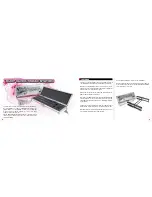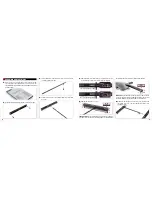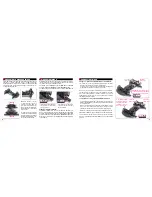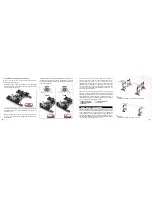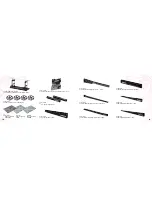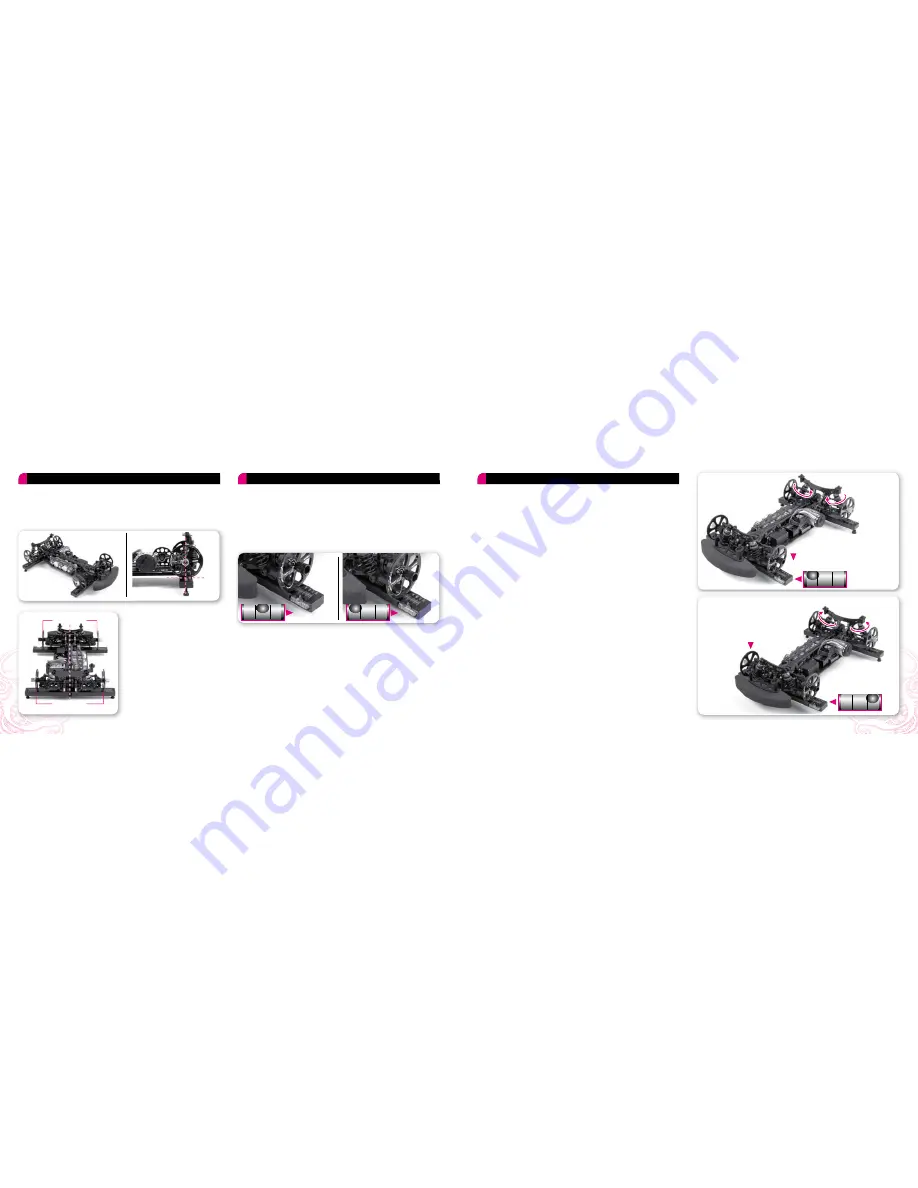
If the FRONT RIGHT
wheel pushes down on
the pivoting base plate,
the REAR LEFT wheel
has too much tension
6
7
PREPARING TO MEASURE TWEAK
MEASURING TWEAK
CORRECTING TWEAK
The weight of rubber tires varies due to the different weights of inserts
and tires. For electric rubber-tired cars we recommend using the
#109370 HUDY alu set-up wheels for rubber tires for better checking
of tweak. For 1/10 electric foam-tired touring cars and pan cars, we
recommend using foam tires.
Adjust the position of the car
to ensure each end of the car is
centered on its base plate. The
outer edge of each wheel (at one
end of the car) should be beside
equivalent marks on each side of
the base plate.
Determine which end of the car you want to check for tweak, and then place
that end of the car (front or rear) on the FIXED base plate. The other end of the
car should be placed on the PIVOTING base plate.
Each type of car platform uses different methods for correcting tweak:
• For touring cars (or other cars with fully-independent suspension), tweak
adjustments are typically made using shock spring preload.
• For pancars (such as 1/12 pancars like the XRAY XII), tweak adjustments
are typically made using tweak screws in the center T-bar.
Refer to your car’s set-up guide for explicit instructions on correcting tweak.
Each time you make an adjustment, re-check the alignment. You shouldn‘t
have to make large adjustments to get things in balance; if you have to
keep making turns and the car does not seem to balance, there is probably
something else that needs attention.
To correct tweak on a touring car with fully-independent suspension:
• If a particular wheel pushes down on the pivoting base plate (causing it to
tilt down), the DIAGONALLY OPPOSITE wheel (on the fi xed base plate) has
too much tension on it.
• When you determine the wheel (on the fi xed base plate) that has too much
tension on it, reduce spring preload on that wheel, and increase spring
preload by an equal amount on the other wheel on the fi xed base plate.
The examples on the right show how to adjust tweak in the REAR suspension -
REAR wheels on FIXED base plate & FRONT wheels on PIVOTING base plate.
To adjust tweak in the FRONT suspension, turn the car around so the FRONT
wheels are on the FIXED base plate and the REAR wheels are on the PIVOTING
base plate.
Example for checking front tweak:
Following the example above, check for rear tweak by placing the rear
wheels on the fi xed base plate, and place the front wheels on the pivoting
base plate. Looking at the front of the car (on the pivoting base plate), if the
base plate is tilted down to the right (under the FRONT RIGHT wheel), that
means there is excess tension on the REAR LEFT wheel (the diagonally-
opposed wheel).
The pivoting base plate will indicate if there is tweak at the OTHER end
of the car.
• If the bubble in the spirit level is
centered, there is no tweak at the
other end of the car.
• If the bubble in the spirit level is
offset to one side, the other end of
the car is tweaked.
For example, if you are measuring
a car with a 190mm track-width, the
outer edge of each wheel should be
beside the engraved number “190”
on each side of the base plate.
For example, to check REAR tweak, place the REAR wheels on the FIXED
base plate, and place the FRONT wheels on the PIVOTING base plate.
Tighten this
spring collar
Tighten this
spring collar
If the FRONT LEFT wheel pushes down
on the pivoting base plate, the REAR
RIGHT wheel has too much tension.
Loosen this
spring collar
Loosen this
spring collar
CENTERED
CENTERED


